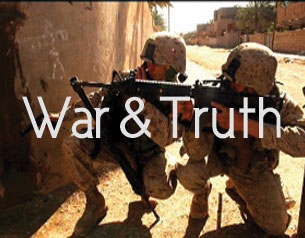War and Truth
The invasion of Iraq was the most extensively reported conflict in history. Over 2,000 journalists descended on the country to send the story home. But how were their stories repackaged, and sanitised ready for public consumption?
 The invasion of Iraq was the most extensively reported conflict in history. Over 2,000 journalists descended on the country to send the story home. But paradoxically, most of what they saw never made the news. This thought-provoking documentary reveals how the war was sanitised and repackaged for the American public. By contrasting coverage of Iraq with the reporting of previous conflicts, it assesses the wider implication of muting the press and questions the role of the media.
The invasion of Iraq was the most extensively reported conflict in history. Over 2,000 journalists descended on the country to send the story home. But paradoxically, most of what they saw never made the news. This thought-provoking documentary reveals how the war was sanitised and repackaged for the American public. By contrasting coverage of Iraq with the reporting of previous conflicts, it assesses the wider implication of muting the press and questions the role of the media.
"If you're going to wage war, modern war, you have absolutely got to be ready to deal with the consequences of it", states Sig Christenson from the San Antonio Express. "If you don't tell the whole story, you're doing a disservice to the people."
During Vietnam, journalists like Roger Peterson travelled with platoons covering the war. But - unlike modern embeds - these reporters were free to come and go as these pleased. "If we were with one company and heard that another company was engaged, we could break away and go and join them", recalls Peterson. "I didn't see any of that in Iraq. For all the people on the field, I saw very little real combat footage."
Peterson and his colleagues were part of a movement respected worldwide which is now regarded as a high point in American journalism. The images they took changed people's perspectives of war and ultimately led to the withdrawal from Vietnam. It was a lesson the military never forgot. "The army in particular felt that the media's exposure of deaths in Vietnam led to a loss of public confidence at home", explains Steve Katz, former counsel to the US Senate Committee on Governmental Affairs. "The media, in the minds of the army, cost them the war."
More than 20,000 Iraqi civilians were killed during Operation Iraqi Freedom. Reporters speak about watching young soldiers scrape melted bodies from the road; of corpses burnt beyond recognition and children dripping with blood. But few of these images were published. "Every photographer has a folder of pictures they know will never see the light of day ", states combat photographer Warren Zinn. "But people need to see those photographs. They need to be educated about war."
"Our coverage was jingoistic and uncritical", complains Danny Schecter, author of 'Death of the Media'. "It was more like cheerleading than reporting." But editor Professor G. Kurt Piehler counters: "There are limits to what you want to show on a public medium, particularly a medium young people will see." Networks were worried about alienating their viewers and losing ratings. A political climate was created where questioning foreign policy and showing what was really happening was perceived as an attack on the army.
But shielding the public from the truth removed one of the most important checks on government. "I think the United States would have made some decisions differently had the public known just how awful things were during the main part of the war," states journalist Dorie Griggs. Prof. John Romeiser agrees. "The kind of news we're getting is not the kind of news that people can look at critically to form their judgements and make sound decisions as voters."
It also left viewers unable to comprehend the subsequent insurgency. As Schechter explains: "If you had watched the coverage, you would not have been prepared for what has happened since in Iraq." But unless people know the full story, they can't avoid repeating the same mistakes. In the words of Christenson: "People are afraid of telling the truth. And this lack of reality is going to be the death of an awful lot of men."
FULL SYNOPSIS
